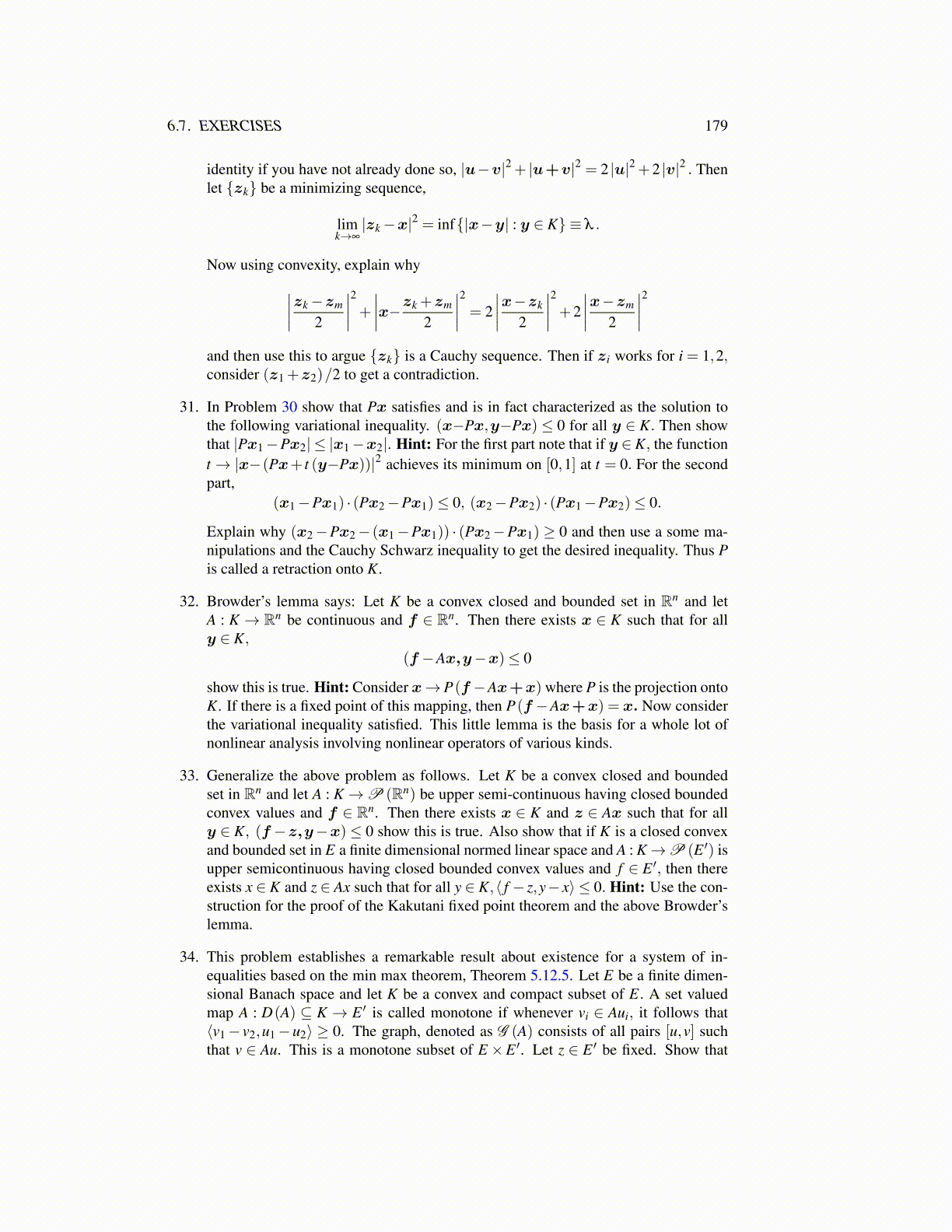
6.7. EXERCISES 179
identity if you have not already done so, |u−v|2 + |u+v|2 = 2 |u|2 +2 |v|2 . Thenlet {zk} be a minimizing sequence,
limk→∞
|zk−x|2 = inf{|x−y| : y ∈ K} ≡ λ .
Now using convexity, explain why∣∣∣∣zk−zm
2
∣∣∣∣2 + ∣∣∣∣x−zk +zm
2
∣∣∣∣2 = 2∣∣∣∣x−zk
2
∣∣∣∣2 +2∣∣∣∣x−zm
2
∣∣∣∣2and then use this to argue {zk} is a Cauchy sequence. Then if zi works for i = 1,2,consider (z1 +z2)/2 to get a contradiction.
31. In Problem 30 show that Px satisfies and is in fact characterized as the solution tothe following variational inequality. (x−Px,y−Px) ≤ 0 for all y ∈ K. Then showthat |Px1−Px2| ≤ |x1−x2|. Hint: For the first part note that if y ∈ K, the functiont → |x−(Px+ t (y−Px))|2 achieves its minimum on [0,1] at t = 0. For the secondpart,
(x1−Px1) · (Px2−Px1)≤ 0, (x2−Px2) · (Px1−Px2)≤ 0.
Explain why (x2−Px2− (x1−Px1)) · (Px2−Px1) ≥ 0 and then use a some ma-nipulations and the Cauchy Schwarz inequality to get the desired inequality. Thus Pis called a retraction onto K.
32. Browder’s lemma says: Let K be a convex closed and bounded set in Rn and letA : K → Rn be continuous and f ∈ Rn. Then there exists x ∈ K such that for ally ∈ K,
(f −Ax,y−x)≤ 0
show this is true. Hint: Consider x→P(f −Ax+x) where P is the projection ontoK. If there is a fixed point of this mapping, then P(f −Ax+x) = x. Now considerthe variational inequality satisfied. This little lemma is the basis for a whole lot ofnonlinear analysis involving nonlinear operators of various kinds.
33. Generalize the above problem as follows. Let K be a convex closed and boundedset in Rn and let A : K→P (Rn) be upper semi-continuous having closed boundedconvex values and f ∈ Rn. Then there exists x ∈ K and z ∈ Ax such that for ally ∈ K, (f −z,y−x)≤ 0 show this is true. Also show that if K is a closed convexand bounded set in E a finite dimensional normed linear space and A : K→P (E ′) isupper semicontinuous having closed bounded convex values and f ∈ E ′, then thereexists x ∈ K and z ∈ Ax such that for all y ∈ K,⟨ f − z,y− x⟩ ≤ 0. Hint: Use the con-struction for the proof of the Kakutani fixed point theorem and the above Browder’slemma.
34. This problem establishes a remarkable result about existence for a system of in-equalities based on the min max theorem, Theorem 5.12.5. Let E be a finite dimen-sional Banach space and let K be a convex and compact subset of E. A set valuedmap A : D(A) ⊆ K → E ′ is called monotone if whenever vi ∈ Aui, it follows that⟨v1− v2,u1−u2⟩ ≥ 0. The graph, denoted as G (A) consists of all pairs [u,v] suchthat v ∈ Au. This is a monotone subset of E ×E ′. Let z ∈ E ′ be fixed. Show that